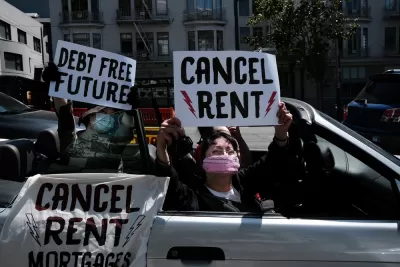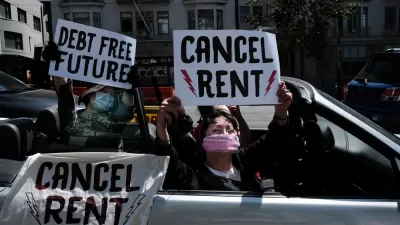The share of U.S. households facing rent debt is decreasing as the economy begins to recover from the pandemic, but rent debt is still concentrated by geography and demographics around the country.

A report by the National Equity Atlas and the Right to the City Alliance, "shows that 14% of all renting households are behind on payments, with the average amount owed being $3,400," reports Elliott Davis. The most recent data are for March, taken from from the U.S. Census Bureau's Household Pulse Survey and five-year 2019 American Community Survey, as well as the University of Southern California's Center for Economic and Social Research.
According to the data, Alabama, Louisiana, and Florida are the states with the highest proportion of households carrying rent debt. Hawaii has the highest rent debt per household. The report lacks data for Mississippi, North Dakota, South Dakota, West Virginia, and Wyoming due to insufficient data. The report also includes data for metropolitan areas.
Davis also notes the "extreme racial and socioeconomic disparities when it comes to who is behind on rent during the coronavirus pandemic." According to the report, "People of color make up 63% of the households that are in rent debt, and 78% are low-income households making less than $50,000, the data indicates."
As mentioned in articles covering the rent debt and eviction crisis in the early days of the pandemic, much of the economic stress of the pandemic has been absorbed by renters already struggling to pay the rent before the pandemic. "The National Equity Atlas' data shows that 46% of Black households, 45% of Latinx households and 42% of Native American households were "rent burdened and economically insecure" in 2019," explains Davis.
FULL STORY: Data Shows 5.7 Million U.S. Households Are Behind on Rent

Montreal Mall to Become 6,000 Housing Units
Place Versailles will be transformed into a mixed-use complex over the next 25 years.

Planetizen Federal Action Tracker
A weekly monitor of how Trump’s orders and actions are impacting planners and planning in America.

DARTSpace Platform Streamlines Dallas TOD Application Process
The Dallas transit agency hopes a shorter permitting timeline will boost transit-oriented development around rail stations.

Without International Immigrants, the Rural US Population Would Be Falling 58%
Census data shows that population growth in rural areas is due in large part to international migrants.

Dead End: Nine Highways Ready for Retirement
The Freeways Without Futures report describes the nation’s most promising highway removal proposals.

Congressman Proposes Bill to Rename DC Metro “Trump Train”
The Make Autorail Great Again Act would withhold federal funding to the system until the Washington Metropolitan Area Transit Authority (WMATA), rebrands as the Washington Metropolitan Authority for Greater Access (WMAGA).
Urban Design for Planners 1: Software Tools
This six-course series explores essential urban design concepts using open source software and equips planners with the tools they need to participate fully in the urban design process.
Planning for Universal Design
Learn the tools for implementing Universal Design in planning regulations.
City of Mt Shasta
City of Camden Redevelopment Agency
City of Astoria
Transportation Research & Education Center (TREC) at Portland State University
City of Camden Redevelopment Agency
Municipality of Princeton (NJ)
Regional Transportation Commission of Southern Nevada





























